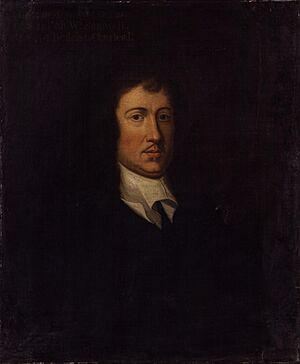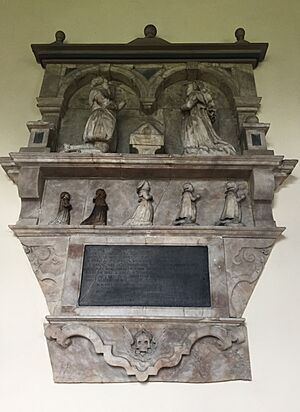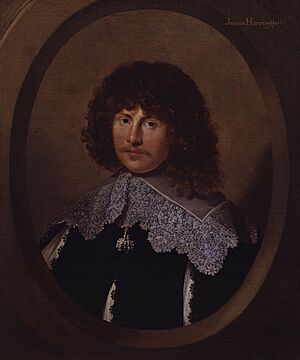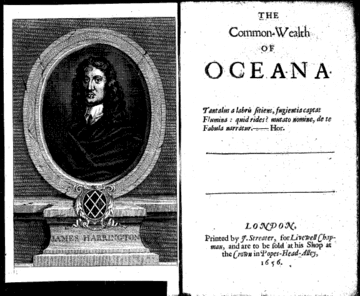James Harrington (author) facts for kids
Quick facts for kids
James Harrington
|
|
|---|---|

James Harrington, portrait by Sir Peter Lely, ca.1658, National Portrait Gallery, London
|
|
| Born | 3 January 1611 Upton, Northamptonshire, England |
| Died | 11 September 1677 (aged 66) Little Ambry, Dean's Yard, Westminster, England |
| Resting place | St Margaret's, Westminster |
| Language | English |
| Nationality | English |
| Citizenship | |
| Education | Trinity College, Oxford |
| Period | European wars of religion |
| Genre | Utopian fiction |
| Subject | Utopia, Republicanism |
| Notable works | The Commonwealth of Oceana |
James Harrington (born January 3, 1611 – died September 11, 1677) was an English thinker. He studied how governments should work. He is famous for his book The Commonwealth of Oceana (1656).
This book described an ideal country, a utopia. It showed how a perfect government could be set up. Harrington hoped his ideas would help England. At that time, England had become a republic after King Charles I was executed in 1649.
Contents
Early Life and Family

James Harrington was born in 1611 in Upton, Northamptonshire. He was the oldest son of Sir Sapcote Harrington. His mother was Jane Samwell. His father died in 1630.
James was the great-nephew of John Harington, 1st Baron Harington of Exton. For a time, James lived with his father in the manor house at Milton Malsor. This house was given to his mother by her father. A special sign, called a blue plaque, marks this house today.
Inside Holy Cross Church in Milton Malsor, there is a monument for James's mother. It is on the south wall of the church. His mother, Dame Jane Harrington, died on March 30, 1619. James was only 7 or 8 years old then.
The monument says that Dame Jane was the daughter of Sir William Samwell. She was the wife of Sir Sapcotes Harington. They had five children: James, William, Jane, Anne, and Elizabeth.
When his father died in June 1630, James ordered another monument. You can still see it in the Church of St Oswald in Rand, Lincolnshire. It shows his father and his first wife Jane with their five children.
Education and Travels
We do not know much about James Harrington's early schooling. But he spent time in both Milton Malsor and Rand. In 1629, he started studying at Trinity College, Oxford. He left two years later without a degree.
After college, Harrington's father passed away. James used his inheritance to travel around Europe for several years. He visited the Netherlands, Denmark, Germany, France, Switzerland, and Italy.
He was in Geneva in the summer of 1635. He also traveled to Rome. It is said that he visited the Vatican and refused to kiss the Pope's foot. His visit to Venice made him very interested in the way Italian republics were governed.
The next ten years of his life are not well known. There are stories that he went with King Charles I to Scotland in 1639. During the English Civil War, he helped Parliament financially. He gave loans and collected money for them.
However, he also worked for Charles Louis, the Prince Elector Palatine. Charles Louis was King Charles I's nephew. His brother, Prince Rupert, led the Royalist army. Even so, Charles Louis and his mother supported Parliament in 1642.
Working for the King
Even though Harrington seemed to support Parliament, he was very loyal to King Charles I personally. After the King was captured, Harrington went with a group of Members of Parliament. They were moving King Charles from Newcastle to Holdenby House.
Harrington's cousin was one of these MPs. This might explain why James went along as a servant to help the King. James continued to serve the King as a "gentleman of the bedchamber." He stayed with the King at Holdenby House, Carisbrooke Castle, and Hurst Castle.
However, at Hurst Castle, Harrington had a discussion with the Governor and army officers. He spoke in favor of the King's ideas about the Treaty of Newport. Because of this, he was dismissed from his service.
Some stories say that Harrington was with King Charles I when he was executed. But these are just rumors and not proven facts.
His Famous Book: Oceana
After King Charles I died, Harrington likely spent his time writing The Commonwealth of Oceana. This book was very important.
However, Oliver Cromwell, who was then England's leader, ordered the book to be stopped. It was seized while it was being printed. But Harrington managed to get help from Cromwell's favorite daughter, Elizabeth Claypole.
The book was returned to him. It was published in 1656 and dedicated to Cromwell. In Oceana, Harrington shared many ideas. These included voting by secret ballot and having different people serve in government roles in turns.
Harrington and others formed a group called the "Rota" in 1659. They tried to make these ideas happen in real life. But they did not have much success.
Later Life and Health
After the King was restored to power in England, James Harrington faced trouble. On November 25, 1661, he was arrested. He was accused of planning against the government. He was put in the Tower of London without a proper court case.
He was treated badly in prison. In April 1662, an order was given to keep him in strict custody. His sisters tried to get him released. But before they could, the authorities quickly moved him to St Nicholas Island near Plymouth.
His brother and uncle managed to get him moved to the fort at Plymouth. They had to pay a large sum of £5000 as a guarantee. After this, Harrington's health quickly got worse.
His mind seemed to be affected. He had some health problems and was sometimes confused. One person thought he was "simply mad." He got a little better, but then his health declined again. He suffered from gout and palsy. Later, he had a stroke that left him unable to move.
Sometime between 1662 and 1669, he married a woman named Mrs. Dayrell. She was his "old sweetheart" and the daughter of a noble family.
James Harrington died in Westminster. He was buried next to Sir Walter Raleigh in St Margaret's, Westminster. There is also a memorial for him at St Michael's Church, Upton.
See also
 In Spanish: James Harrington para niños
In Spanish: James Harrington para niños
- Gawthorpe Hall has a picture of Harrington




